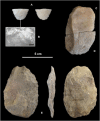Campo Laborde: A Late Pleistocene giant ground sloth kill and butchering site in the Pampas
- PMID: 30854426
- PMCID: PMC6402857
- DOI: 10.1126/sciadv.aau4546
Campo Laborde: A Late Pleistocene giant ground sloth kill and butchering site in the Pampas
Abstract
The extinction of Pleistocene megafauna and the role played by humans have been subjects of constant debate in American archeology. Previous evidence from the Pampas region of Argentina suggested that this environment might have provided a refugium for the Holocene survival of several megamammals. However, recent excavations and more advanced accelerator mass spectrometry radiocarbon dating at Campo Laborde site in the Argentinian Pampas challenge the Holocene survival of Pleistocene megamammals and provide original and high-quality information documenting direct human impact on the Pleistocene fauna. The new data offer definitive evidence for hunting and butchering of Megatherium americanum (giant ground sloth) at 12,600 cal years BP and dispute previous interpretations that Pleistocene megamammals survived into the Holocene in the Pampas.
Figures





References
-
- Barnosky A. D., Koch P. L., Feranec R. S., Wing S. L., Shabel A. B., Assessing the causes of late Pleistocene extinctions on the continents. Science 306, 70–75 (2004). - PubMed
-
- Koch P. L., Barnosky A. D., Late Quaternary extinctions: State of the debate. Annu. Rev. Ecol. Evol. S. 37, 215–250 (2006).
-
- A. L. Cione, E. P. Tonni, L. Soibelzon, Did humans cause the Late Pleistocene-Early Holocene mammalian extinctions in South America in a context of shrinking open areas? in American Megafaunal Extinctions at the End of the Pleistocene, G. Haynes, Ed. (Springer, 2009), pp. 125–144.
-
- Villavicencio N. A., Lindsey E. L., Martin F. M., Borrero L. A., Moreno P. I., Marshall C. R., Barnosky A. D., Combination of humans, climate, and vegetation change triggered Late Quaternary megafauna extinction in the Última Esperanza region, southern Patagonia, Chile. Ecography 39, 125–140 (2016).
-
- Ripple W. J., Van Valkenburgh B. V., Linking top-down forces to the Pleistocene megafaunal extinctions. Bioscience 60, 516–526 (2010).
Publication types
MeSH terms
LinkOut - more resources
Full Text Sources

